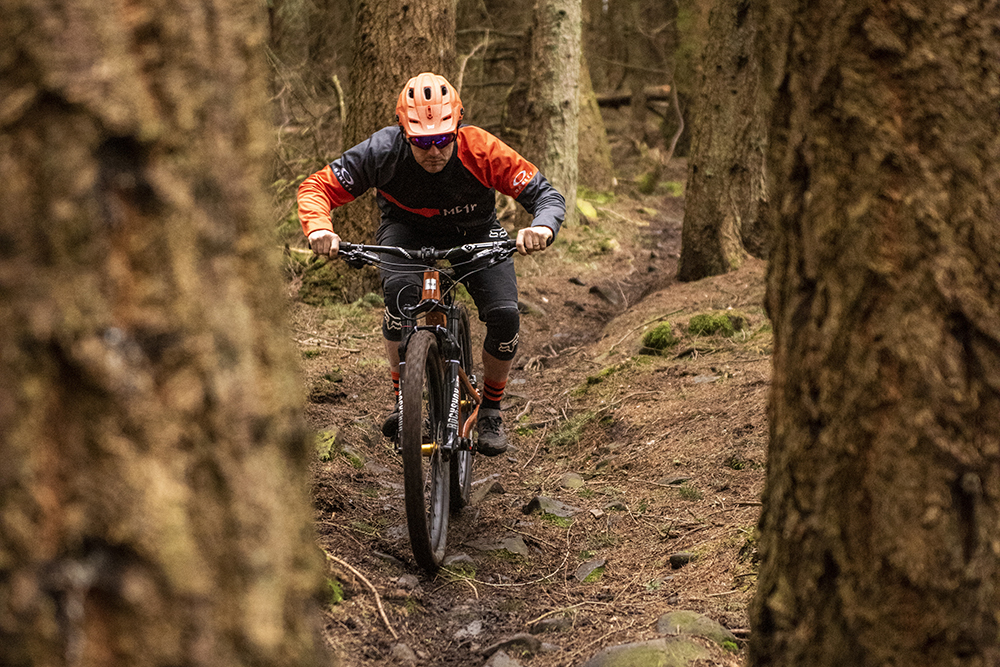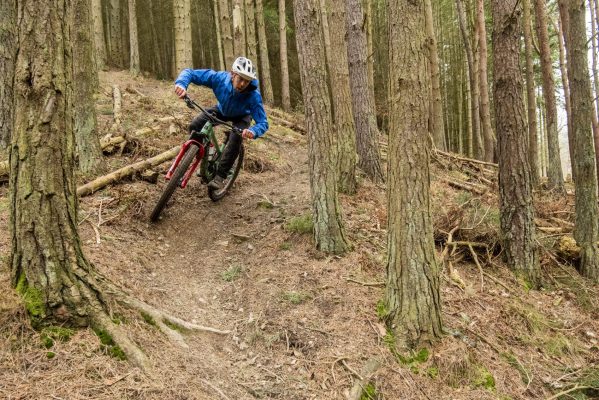How to tame steep trails
Don’t be intimidated by steep trails; learn the skills to handle even the gnarliest of tracks with control and confidence.
>>> Six tips on how to ride faster
Words by Andy Barlow | Dirt School

Natural trails are a challenge that most riders love. With so much going on they really test even a capable rider’s ability. If you’re riding natural, then in most locations it doesn’t take long before they also get steep. While natural trails themselves pose a test because of the features, texture of the ground, roots or rocks and lack of grip in places, it all gets amplified when they get steep.
We’re going to talk you through how to balance your acceleration with the available traction. We’ll look at keeping your body weight neutral even on the most terrifying of descents. And we’ll give you an insight to how more confident riders make it look so easy.

Maintaining a low body position is the key to unlocking steep trails. Look how much room Jimmy has to move here. If his wheels slide on the roots he still has plenty room to allow for balance
Range of motion
As always we’re going to start with the amount of movement that you can use. If you’re upright or hanging back with limited range of motion in your arms, then you’re going to run out of control pretty quickly. Stay low and keep your head over the bars and stem and you’ll be able to neutralise your body weight by keeping it isolated from the movement that your bike is doing beneath you.
How do I stop slipping on the roots?
The honest answer is that you don’t. Roots and rocks can be slippy, and will cause your bike to move about underneath you if they’re wet enough. The trick is to give yourself the range of motion that allows for this movement. Then you can extend into it allowing your body weight to stay neutral. Just remember to reset your low neutral riding position after every movement.

Bent elbows allow for shock absorption
I thought my elbows WERE bent!
James was really good at staying low on the way into things, but as soon as he felt a little movement happen he’d be creeping back to a more upright shape that he was more familiar with. Sessioning a steep section is a really good way of sorting this out. The first time through a section you are just reacting to what’s coming up. Once you’ve ridden it though you open up time to think, so by the third or fourth pass of a section you can really focus on your technique.
Do I just keep my weight back?
In a nutshell. NO. Don’t keep your weight back. Ever. As soon as your arms are straight then you don’t have anywhere to go to, and you’ll inevitably get pulled forwards as your bike dives off things in front of you. Keep your head close to the bars and your elbows bent and you’ll be able to let your front wheel drop off down all kinds of shapes without it affecting you or your balance at all. You’ll stay neutral and have much more control over your traction and balance.

This trail is as steep as they come and there’s no sign of keeping your weight back. Stay low and allow for movement.
Really steep
Once things become really steep you have to just go with it. Most of the time these sections only last a few meters, so you don’t have to commit to an entire trail, but you will have to just come out of your comfort zone for a few seconds if you want to get through it clean. If you try and stop on a section like this you’ll use up too much of your traction and end up skidding out of control. This loss of traction – most likely from your front wheel, will result in a crash.
Instead try and be cool with the fact that even braking as much as you can get away with will only keep your speed consistent. It won’t slow you down. The best that you can hope for on a section like this is that you don’t accelerate any more. Look for the next turn or traverse and focus on getting your control back on that rather than panicking on the steep chute.

Keep facing the way you want to go – both with your upper body and your hips.
Neutral riding position
A lot of the time on a technical trail you really want your wheels to be in exactly the right place. If you end up on the wrong side of a root then it could lead you into a place where you don’t want to be. Remember and keep your head in the middle of the bars and your low body position connected with your bars, forks, and front end of your bike. If you need to balance, instead of steering or disconnecting your body to swing one way or the other, try keeping your head in the middle of the handlebars and throwing a knee out. The disconnect should be from your hips or legs. This means that you can make minor adjustments to your balance with ought ever sacrificing your stable neutral body position.
Jimmy spends a lot of time in the gym with clients perfecting their technique, or looking over their shoulder to keep up with how their training plan is going. Giving his clients feedback means that they can change what they’re doing and get more out of their sessions. It’s a lot more satisfying knowing that you’re making the best use of your time and Jimmy was responding well to his feedback as always.
Patience
At times you’re going to have to slow down to almost a stall to take control of your momentum. Take your time and be patient on the way in, and as you roll off your brakes and commit to the next technical section let the hill come to you. If it’s steep enough then you’ll be up to speed up in no time at all, so you don’t have to go looking for the speed on the way in. It’s more important to open up that time to react. You can always add speed by braking less. It’s very difficult to scrub speed once you have it.

Look how Andy is using his knee to balance instead of steering or moving his shoulders. His head is central and his body is neutral and lined up with the bars.
Gravity vs grip
The scary thing about riding on steeper terrain is the acceleration. You’re always trying to fight against the feeling that gravity is just making you go faster all the time. If you were riding down a consistently steep road with loads of traction, then you’d be able to balance that acceleration by pulling your brakes to a particular amount and staying at a constant speed.
The difference with riding off road is that there will be places on the trail where you have loads of grip, and there’ll be places where you either don’t have very much grip, or you’re having to let go of your brakes to stay fluid over bigger features. In either case you’re going to have to brake more where you can trust it, and less in the places where you need control or want to stay fluid.
Balance your acceleration
Once you start braking more where you have grip and allowing the bike to roll freely on the places where you need more control, you’ll be able to gauge your acceleration much better. You can predict that you’ll get faster over the rougher stuff, but you can throw down the anchors when the traction appears on the other side. This might see counter intuitive at first as you’ll be getting faster on all the harder stuff, but try on focus on getting as much control over your speed in the places that you can trust and you’ll have more balance, control and ultimately confidence going into the places where it get’s a little more lively.

Getting off and taking a look allows you the time to make a plan.
Look for control
With everything that’s going on it’s going to be really tempting to focus on the negative aspects of what’s coming up. Roots, exposure, tree stumps, rocks… There’s loads of clutter that can be very off putting on first glance. Instead, try and look for the smoother parts of a trail. You’re trying to seek out the cambers that will catch you, the smooth ground that you can brake on, the open ground that exits corners and the grip points that you can rely on. Deliberately read a trail like this and you’ll change how you’re thinking about it. Instead of seeing all the dance you’ll be looking at all the good things that are working in your favour.
Time to traverse
To use a skiing analogy, if you watch anyone tackling a steep slope on a pair of skis they traverse from one side of the slope to the other. They do all of their turn in one spot, then they traverse back across the slope again. This means that they’re able to control a lot of their acceleration because they’re not getting the full force of gravity that they’d experience if they aimed straight down the slope. On steeper mountain bike trails however it’s amazing how many riders just point straight down the trail and hang off the back of their bikes hoping to slow down! This is the equivalent of trying to control your skis by snowploughing in a straight line directly down the mountain. It just doesn’t work. Instead, try and traverse across the trail so that you have time to apply the brakes and gain control over your momentum.

Taking the high line allows you time to do a lot of the turn before the acceleration starts taking over.
High line hero
When corners are involved on a steep trail the best thing you can do is set up wide. Use the traverse to brake, take control, and set up high, but don’t turn down right away. Instead stay high later than you think. You should be able to do a lot of the turn while you’re going slowly at the top, so that as you turn down and start building speed you are able to complete the turn with time to spare. Going up the inside of a steep turn means that you’re doing the acceleration before you’ve done any of the turn. Stay up high later than normal and you’ll be able to do a lot of the turn before you’ve done any acceleration.
Game plan: Stay Low
The next time you’re on a steeper trail really think about your body position. It will be easy to stay low on the way in, but the track is to catch yourself in those moments where you lose control, or leave your comfort zone. Try and catch yourself going back or locking up and come back down to a place where you have maximum range of motion. This control over your body weight will mean that you have more consistent and predictable traction, more time to react, and ultimately be riding safer and faster with less risk. It’s okay to get off the back now and again, but snap right back to a low attack position and you’ll stay fluid and confident on even the steepest of trails.




